Os diretores podem
adicionar sua marca registrada nos filmes que fazem. O mesmo acontece com
atores, alguns roteiristas, cenógrafos e figurinistas. Mas pouquíssimos
coreógrafos conseguiram adicionar uma marca registrada aos filmes em que
trabalharam. Eu consigo pensar em apenas um que conseguiu fazer isso, e criar
um estilo fácil de reconhecer: Busby Berkeley.
Directors can add their
touch to the films they work in. The same happens to actors, some
screenwriters, set designers and costume designers. But very few choreographers
were able to add an indelible touch to the films they worked in. I can think
about only one who was able to do that, and create a recognizable style: Busby
Berkeley.
Sempre que pensamos em
Busby Berkeley, pensamos em preto e branco. Seus filmes mais conhecidos foram
feitos no começo dos anos 30, durante a era pre-Code, nos estúdios Warner Bros.
Entretanto, ele também levou suas danças caleidoscópicas para filmes em cores,
antes e depois do auge de sua carreira. E o efeito foi impressionante como de
costume – e talvez até um pouco mais surpreendente.
Whenever we think about
Busby Berkeley, we think in black and white. His most famous movies were made
in the early 1930s, during the pre-Code era, at the Warner Bros Studios.
However, he also worked, with his kaleidoscopic routines, in color films before
and after his heyday. And the effect was as impressive as always – if not more.
O primeiro filme em que
Busby Berkeley trabalhou foi “Whoopee!”, de 1930, produzido pelo próprio Florez
Ziegfeld e Samuel Goldwyn. As estrelas são Eddie Cantor, Paul Gregory e Eleanor
Hunt. A maioria do elenco e equipe veio da montagem da peça na Broadway – os
direitos da peça foram vendidos por Ziegfeld para Goldwyn logo após a quebra da
bolsa de valores de 1929.
Busby Berkeley’s first film
was 1930’s “Whoopee!”, a film produced by Florenz Ziegfeld – the man himself –
and Samuel Goldwyn. It stars Eddie Cantor, Paul Gregory and Eleanor Hunt. Most
of the cast and crew came from the Broadway production of the play, whose
rights were sold from Ziegfeld to Goldwyn after the 1929 stock market crash.
Em “Whoopee!” lemos os
créditos ‘danças e coro coreografados por Busby Berkeley’. Temos de esperar
apenas três minutos para uma sequência de canto e dança, e aí já nos
encontramos em território familiar: é o mesmo Busby Berkeley que conhecemos e amamos,
com as formas geométricas criadas pelos dançarinos e capturadas por uma câmera
suspensa. A única diferença é que a sequência é em cores – em two-strip
Technicolor.
In “Whoopee!” we read the
credits ‘dances and ensembles staged by Busby Berkeley’. We have to wait only
three minutes to have a song and dance sequence, and we find ourselves in
familiar territory: it’s the same Busby Berkeley style we know and love, with
geometric shapes created by the dancers and captured by the camera from above.
The only difference is that it’s in color – two-strip Technicolor.
Este primeiro número de
dança é o que mais se aproxima do trabalho posterior de Berkeley – os outros
números são muito tímidos e contidos. Perto do fim temos também uma pequena
formação em caleidoscópio com índias. E estes são os destaques de um filme
muito divertido que tem alguns momentos vergonhosos para manchar sua reputação
– uma palavra: blackface.
This first dance sequence is
the closest we have from Berkeley’s later work – other ensemble numbers in the
film look too timid in comparison. Near the end we also have a small
kaleidoscopic formation with Indian girls. These are the highlights of a funny
and enjoyable film that has a few shameful moments to stain its reputation –
one word: blackface.
Eu adoro o Technicolor
primitivo (chamado também de two-strip Technicolor). Como as cores principais
neste processo são vermelho e verde, o resultado final é um filme
predominantemente bege e cheio de detalhes rosados – destaque para as bochechas
e as roupas das dançarinas. O efeito não é psicodélico, mas sim delicado – e
não podemos nos esquecer de que a cópia de “Whoopee!” que temos hoje já se
desgastou e tem uma aparência diferente da que tinha em 1930, quando o filme
foi um sucesso de bilheteria.
I love two-strip Technicolor
– probably more than I should. Because red and green were the main colors
recorded in the process, the final result was a beige-ish film full of rosy
details – like the chorus girls’ cheeks and clothes. The effect is not psychedelic,
but delicate – and we shall not forget that the copy of “Whoopee!” we have
today has faded in comparison to what it looked like in 1930, when “Whoopee!”
was a box-office hit.
Busby Berkeley
trabalharia novamente em um filme a cores apenas nos anos 40. Ele havia sido
‘emprestado’ para a 20th
Century Fox para criar alguns números de dança hipnóticos para “Entre a Loura e
a Morena” (1943). Além de criar estes efeitos incríveis com luzes coloridas,
Busby teve seu momento mais ousado e psicodélico com o número ‘The Lady in the
Tutti Frutti Hat’. Frutas gigantes foram parte da coreografia e a extravagante
Carmen Miranda se mostrou a peça perfeita para ficar no centro do caleidoscópio
de Busby Berkeley.
Busby Berkeley would only
work in color films again in the 1940s. He was working as a loan to 20th
Century Fox when he developed some hypnotic dance numbers for “The Gang’s All
Here” (1943). Besides creating some amazing effects with colorful lights, Busby
had his most daring and psychedelic moment in the number ‘The Lady in the Tutti
Frutti Hat’. Giant fruits were part of the choreography and extravagant Carmen
Miranda showed she was a perfect piece to be in the center of Berkeley’s
kaleidoscope.
De volta à MGM, Busby
Berkeley trabalhou em “Romance em Alto Mar” (1948) e “A Bela Ditadora” (1949).
Ambos os filmes têm números de dança com uma profusão de cores, mas nada que se
compare ao trabalho pregresso de Berkeley. Há sequências charmosas e com boa
coreografia, mas está faltando o toque de Berkeley.
Back at MGM, Busby Berkeley
worked at “Romance on the high Seas” (1948) and “Take Me Out to the Ballgame”
(1949). Both are films with colorful dance sequences, but nowhere as bold as
Berkeley used to do. There are charming, well-choreographed sequences, but not
the Berkeley touch.
Berkeley teve mais uma
chance de mostrar seu talento para criar coreografias geométricas – e fez isso
dentro d’água: o filme foi “A Rainha do Mar” (1952). Este é um aqua-musical e
também a cinebiografia da nadadora e estrela de cinema Annette Kellermann. A
estrela do filme é Esther Williams, e os números criados por Berkeley são de
tirar o fôlego. Somos capazes de reconhecer o estilo dele quando centenas de
homens e mulheres que mergulham, nadam e criam formas geométricas em piscinas
enormes. Berkeley e Esther Williams trabalharam juntos novamente no ano
seguinte em “Fácil de Amar”.
Berkeley had one more chance
to showcase his talent for creating geometric choreographies – and he did it at
the water: the film was “Million Dollar Mermaid” (1952). It is an acqua-musical
and also the biopic of swimmer and film star Annette Kellermann. The star of
the movie is Esther Williams, and the numbers staged by Berkeley are just
breathtaking. You can recognize his style as hundreds of girls and men dive, swim
and create geometric shapes in huge pools. Berkeley and Esther Williams worked
together again the following year in “Easy to Love”.
O último filme de Busby
Berkeley foi “A Mais Querida do Mundo” (1962). Ele faleceu 14 anos depois, aos
80 anos. Embora seus trabalhos mais conhecidos possam ser vistos apenas em
preto e branco, ele felizmente trabalhou também em filmes em cores, e teve a
chance de fazer seu talento brilhar em Technicolor. Estes filmes em cores são o
que temos de mais próximo do trabalho de Busby Berkeley nos palcos da Broadway,
e devemos agradecer pela oportunidade de ter Berkeley imortalizado em película
também em cores.
Busby Berkeley’s last film
was “Billy Rose’s Jumbo” (1962). He died 14 years later, in 1976, when he was
80. Although his most famous work can only be seen in black and white, he
luckily also worked in color films, and was able to make his talent shine in
Technicolor. These colorful films are the closest we’ll have from Busby Berkeley’s
work on the Broadway stage, and we must be thankful for the opportunity to have
Berkeley immortalized on celluloid also in color.
This is my contribution to the Busby Berkeley blogathon, hosted by Hometowns to Hollywood.

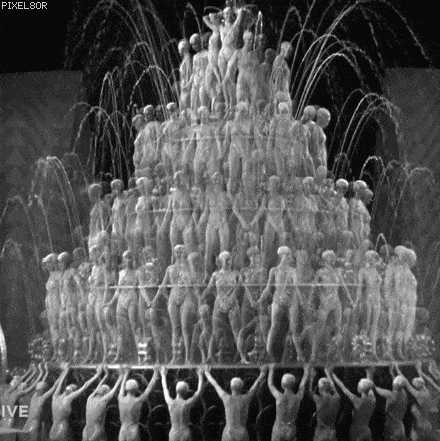


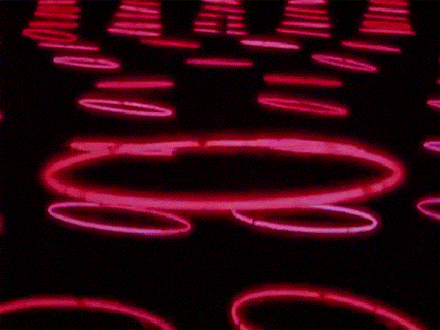
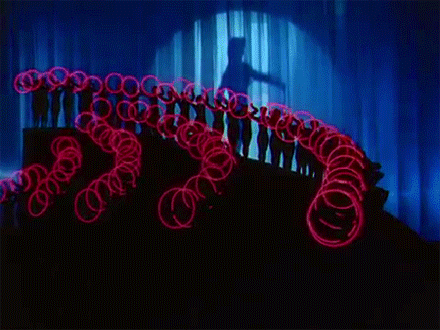




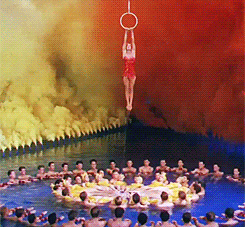
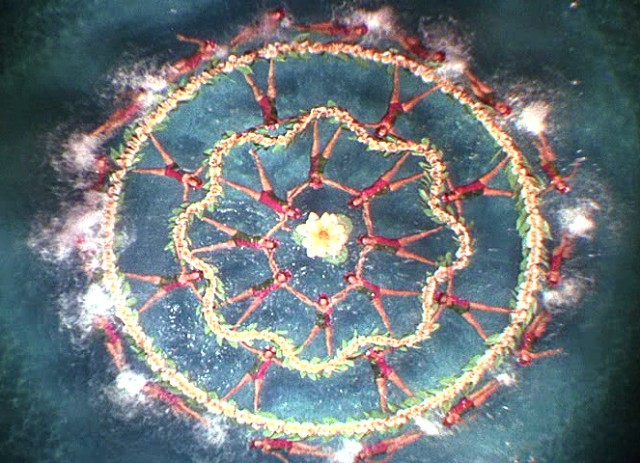


6 comments:
Didn't know Berkeley worked in color. It makes his dance numbers look even more over-the-top than usual.
These gifs are amazing, BTW.
Great post! It's interesting how we think of black and white and Berkeley together, even though he did some amazing work in color, as you pointed out. So glad to see you didn't forget his work with Esther, too! :)
Oops, "his work with Esther," not "your"!
When I think of Berkeley I usually think of large scale dance sequences like this. Which is probably why I opted to choose a more refined and limited sequence for my entry, LOL...
That sequence in two-strip Technicolour is SO beautiful. It's not as elaborate as some of his later work but, like you said, the style is all Busby Berkeley.
I'm glad you wrote about Berkeley in colour – his work all the more dazzling.
I didn't know about Berkeley's connection to Whoopee--thanks for that! I saw The Gang's All Here and my jaw just kept dropping more and more at the fun tropical visual effects. Thank you so much for participating in the Busby Berkeley Blogathon!
Post a Comment